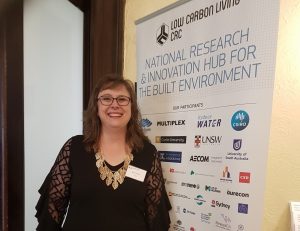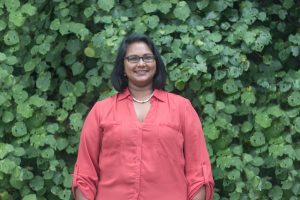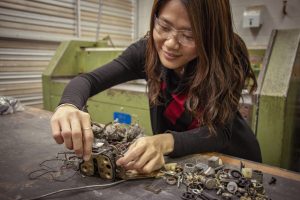Women on a mission
By Femi Perumbally, thinkstep-anz
Every woman in engineering and manufacturing has her own unique experience to share. To understand the role and experiences of women working in this area, ways of moving forward, and the benefits of diverse workplaces, we talked to some of the best sources we have: our female engineers at thinkstep-anz.
Nicole Sullivan, Gaya Gamage, and Vi Kie Soo are three engineers from varied backgrounds who are applying their knowledge and experience to further sustainability efforts in New Zealand and Australia with thinkstep-anz.
Women in engineering have struggled with many issues over the years, from unsuitable working conditions and unfair compensation, to limited recognition for achievements, and unequal advancement opportunities.
Although women still face many of the same issues to a smaller degree, this is slowly changing over time, as mirrored by the experiences of our female employees.
Nicole, Gaya, and Vi Kie have a combined experience in academia and industry, and in areas spanning civil, environmental, electrical, process, and chemical engineering.
We look at their diverse experiences in occupying male-dominated careers and the sustainability glue connecting their narratives.
Standing out in a sea of hard-hats
 Nicole joined thinkstep-anz in late 2020 as Head of Strategy and Impact, adding sustainability consulting to an already impressive list of roles.
Nicole joined thinkstep-anz in late 2020 as Head of Strategy and Impact, adding sustainability consulting to an already impressive list of roles.
With a degree in Chemical Engineering and 18 years of process engineering experience, Nicole understands manufacturing at what she calls the ‘hard-hat level’.
She also understands the experience of being the only woman in a hard-hat, having been in such a situation many times and in many contexts.
Being the only woman among hundreds of people while working in environmental management on one of the biggest projects at BlueScope took this experience to another level.
For Senior Sustainability Specialist Gaya, working with clients such as NZ Steel and Tasman Insulation in a male dominated client base has not led her to feel out of place as a woman.
Gaya’s experience in academia is another story. Even equipped with a PhD in Civil and Environmental Engineering, there are many instances she recalls being treated differently — considered like a student by those with similar qualifications, having technical material explained with unnecessary detail and many other moments like it.
Senior Sustainability Consultant Vi Kie’s experience was slightly different as she transitioned into manufacturing after academia.
When the award-winning researcher and systems engineer switched gear to manufacturing, many years after Nicole, she faced a similar reality: a less than even representation of women in the steel and metal industries that persists today.
Bridging the worlds of sustainability, manufacturing, and engineering
While their recollections highlight individual differences, Nicole, Gaya, and Vi Kie also share what draws them to male-dominated industries and careers, besides an interest in the technical world —the desire to provide sustainability solutions to the manufacturing industry.
Nicole knows what it is like to succeed in male dominated workspaces. She has many career highlights — playing a pivotal role in bringing industry leading initiatives to the forefront of the manufacturing and construction sectors during her time at BlueScope and the GBCA.
Now, the industry insider’s focus is on being the bridge between manufacturing, engineering, and sustainability.
As an engineer today, she sees her value in bringing an understanding of manufacturing and engineering into sustainability as they are often viewed as separate.
 Gaya’s more ‘traditional’ approach to engineering — focusing on the work behind-the-scenes and making the numbers count — makes her well-suited to guiding companies towards green action rather than ‘greenwash’.
Gaya’s more ‘traditional’ approach to engineering — focusing on the work behind-the-scenes and making the numbers count — makes her well-suited to guiding companies towards green action rather than ‘greenwash’.
Getting environmental thinking in the mix as early as possible remains Gaya’s priority with the projects she works on.
Vi Kie is highly interested in promoting holistic approaches to sustainability such as Life Cycle Assessment (LCA) and the circular economy.
While the three engineers are united by a shared vision to connect the worlds of manufacturing and engineering with sustainability, Vi Kie is also focused on the upcoming generations of female engineers.
Guiding the younger generation
The youngest of the trio profiled here, Vi Kie is passionate about encouraging the upcoming generation of female engineers. She has never let considerations such as imbalanced gender ratios hold her back from her calling.
I just do what I like. It never occurred to me that I cannot or should not follow my chosen career path because of the lack of women in engineering — or any other reason for that matter,” she says confidently.
The motto has worked well for Vi Kie in industry and academia. She is keen to pass her motto on to girls as an advocate for introducing science, technology, engineering, and mathematics (STEM) topics from a young age.
Although unstoppable in following her desired career, Vi Kie is keenly aware of the role that mentorship and support programmes can play in encouraging women to not only enter but also thrive in engineering and manufacturing roles.
In 2021, the Diversity Agenda reported that around 29 percent of women engineers and architects leave within the first 5 years.
Mentorships also provide a better understanding of what challenges women will face, and create a safe space for building resiliency to the difficulties that can occur in workspaces that have been or are traditionally occupied by men.
Vi Kie actively takes part in opportunities to engage with younger audiences such as STEM panel talks. “Sharing our experiences as professionals in the field is the best way to encourage young women to try it”, says Vi Kie. While she works to inspire the next generation of women following a similar path, she turns to the women she works with for her own inspiration. 
Being inspired by the qualities of female leaders
At thinkstep-anz, all of Vi Kie’s projects since starting have been led by women including Gaya and Nicole, providing a source of inspiration.
The number of women in leadership positions at thinkstep-anz — including the CEO, Barbara Nebel — is not taken for granted even by those in senior roles already.
“Within thinkstep-anz, we have always had a woman at the helm and Team Leads who’ve almost always been women. In this setting, I don’t feel limited as a woman. Outside may be a different story,” says Gaya.
Vi Kie notes that the women tend to work in different ways; they are highly organised and bring a different perspective and energy to their roles as engineers and leaders.
For engineers in manufacturing, there can be an unspoken expectation to be ‘one of the boys’. Widening the conversation allows for women to be women and still do their job well.
Diversity needs to always be in mind for this conversation — creating a win-win situation for organisations with the creativity and innovation that comes with different people and backgrounds.
Why we still need to have this conversation
There is more representation of women in engineering colleges, partially helped by targets in place to achieve a certain percentage of women in academia, and increasing number of mentorship programmes catered for women to understand challenges that are more specific to women.
“We have made strides from my experience working with clients. We don’t need to explain why we [women] are here anymore,” says Gaya.
Yet, the engineering world still remains quite male dominated, women make up only 14 percent of engineers (Diversity Agenda, 2021). There would be no need for this conversation otherwise.
“You just have to walk into a manufacturing facility to see it,” explains Nicole. The sentiment is echoed by Vi Kie who found that there was better representation while studying than in manufacturing.
Women are one part of a wider conversation
Manufacturing organisations can address the gender imbalance by considering the added benefits that diverse employees bring to a role — whether it be by gender, age, ethnicity etc.
These include anything from a more diverse academic or work background, to different approaches to problem solving and project management, ultimately working for an organisation’s best interests. Furthermore, there needs to be an awareness of unconscious biases present in the recruiting process among companies.
More work towards changing outdated attitudes, creating opportunities, and improving work environment for women in such spaces is equally important.
“Companies like thinkstep-anz are ahead of the curve by providing equal opportunities for women in engineering and leadership positions.
We need this to become the norm not the outlier,” says Gaya. That means we need to start the conversation early.
Vi Kie sums it up: “There’s no gender-based occupation; we need to instil this in children from a very young age to open up the opportunities for both girls and boys.”



